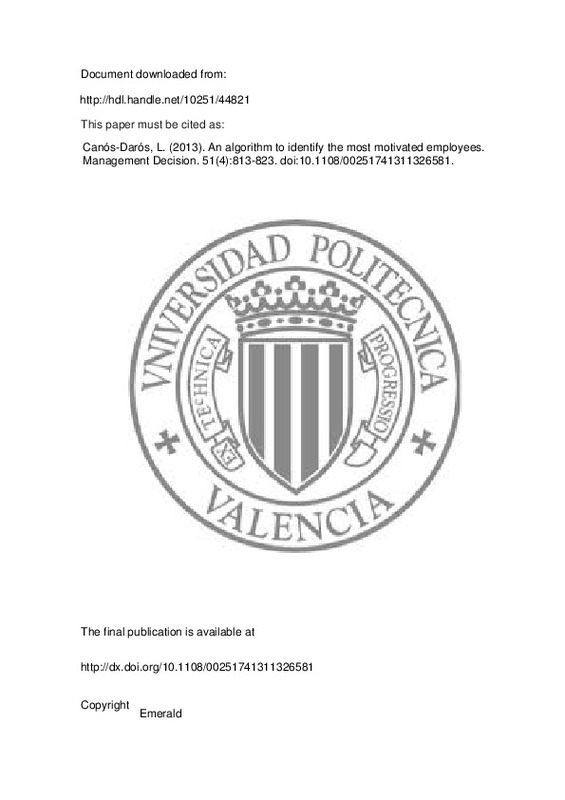Baddoo, N., Hall, T., & Jagielska, D. (2006). Software developer motivation in a high maturity company: a case study. Software Process: Improvement and Practice, 11(3), 219-228. doi:10.1002/spip.265
Campbell, D. J., Campbell, K. M., & Chia, H.-B. (1998). Merit pay, performance appraisal, and individual motivation: An analysis and alternative. Human Resource Management, 37(2), 131-146. doi:10.1002/(sici)1099-050x(199822)37:2<131::aid-hrm4>3.0.co;2-x
Chen, S.-H. (1985). Ranking fuzzy numbers with maximizing set and minimizing set. Fuzzy Sets and Systems, 17(2), 113-129. doi:10.1016/0165-0114(85)90050-8
[+]
Baddoo, N., Hall, T., & Jagielska, D. (2006). Software developer motivation in a high maturity company: a case study. Software Process: Improvement and Practice, 11(3), 219-228. doi:10.1002/spip.265
Campbell, D. J., Campbell, K. M., & Chia, H.-B. (1998). Merit pay, performance appraisal, and individual motivation: An analysis and alternative. Human Resource Management, 37(2), 131-146. doi:10.1002/(sici)1099-050x(199822)37:2<131::aid-hrm4>3.0.co;2-x
Chen, S.-H. (1985). Ranking fuzzy numbers with maximizing set and minimizing set. Fuzzy Sets and Systems, 17(2), 113-129. doi:10.1016/0165-0114(85)90050-8
Choobineh, F., & Li, H. (1993). An index for ordering fuzzy numbers. Fuzzy Sets and Systems, 54(3), 287-294. doi:10.1016/0165-0114(93)90374-q
Cory, S.N., Ward, S. and Schultz, S.A. (2007), “Managing human resources in a small firm. Motivation through performance evaluation”, The CPA Journal, October, pp. 62‐65.
DeVoe, S. E., & Iyengar, S. S. (2004). Managers’ theories of subordinates: A cross-cultural examination of manager perceptions of motivation and appraisal of performance. Organizational Behavior and Human Decision Processes, 93(1), 47-61. doi:10.1016/j.obhdp.2003.09.001
Dieleman, M., Toonen, J., Touré, H., & Martineau, T. (2006). The match between motivation and performance management of health sector workers in Mali. Human Resources for Health, 4(1). doi:10.1186/1478-4491-4-2
Fortemps, P., & Roubens, M. (1996). Ranking and defuzzification methods based on area compensation. Fuzzy Sets and Systems, 82(3), 319-330. doi:10.1016/0165-0114(95)00273-1
Garg, P., & Rastogi, R. (2006). New model of job design: motivating employees’ performance. Journal of Management Development, 25(6), 572-587. doi:10.1108/02621710610670137
Gholipour, A., Pirannejad, A., Kozekanan, S. F., & Gholipour, F. (2011). Designing Motivation System to Produce Creativity and Entrepreneurship in Petrochemical Company. International Journal of Business and Management, 6(5). doi:10.5539/ijbm.v6n5p137
Glen, C. (2006). Key skills retention and motivation: the war for talent still rages and retention is the high ground. Industrial and Commercial Training, 38(1), 37-45. doi:10.1108/00197850610646034
James, H. S. (2005). Why did you do that? An economic examination of the effect of extrinsic compensation on intrinsic motivation and performance. Journal of Economic Psychology, 26(4), 549-566. doi:10.1016/j.joep.2004.11.002
Kuvaas, B. (2006). Work performance, affective commitment, and work motivation: the roles of pay administration and pay level. Journal of Organizational Behavior, 27(3), 365-385. doi:10.1002/job.377
Mathauer, I., & Imhoff, I. (2006). Health worker motivation in Africa: the role of non-financial incentives and human resource management tools. Human Resources for Health, 4(1). doi:10.1186/1478-4491-4-24
Orpen, C. (1994). Interactive Effects of Work Motivation and Personal Control on Employee Job Performance and Satisfaction. The Journal of Social Psychology, 134(6), 855-856. doi:10.1080/00224545.1994.9923021
Peterson, T. M. (2007). Motivation: How to Increase Project Team Performance. Project Management Journal, 38(4), 60-69. doi:10.1002/pmj.20019
Reis, D., & Peña, L. (2001). Reengineering the motivation to work. Management Decision, 39(8), 666-675. doi:10.1108/eum0000000005929
Story, P. A., Hart, J. W., Stasson, M. F., & Mahoney, J. M. (2009). Using a two-factor theory of achievement motivation to examine performance-based outcomes and self-regulatory processes. Personality and Individual Differences, 46(4), 391-395. doi:10.1016/j.paid.2008.10.023
Tabassi, A. A., & Bakar, A. H. A. (2009). Training, motivation, and performance: The case of human resource management in construction projects in Mashhad, Iran. International Journal of Project Management, 27(5), 471-480. doi:10.1016/j.ijproman.2008.08.002
Tietjen, M. A., & Myers, R. M. (1998). Motivation and job satisfaction. Management Decision, 36(4), 226-231. doi:10.1108/00251749810211027
Van Knippenberg, D. (2000). Work Motivation and Performance: A Social Identity Perspective. Applied Psychology, 49(3), 357-371. doi:10.1111/1464-0597.00020
Vollmeyer, R., & Rheinberg, F. (2000). Does motivation affect performance via persistence? Learning and Instruction, 10(4), 293-309. doi:10.1016/s0959-4752(99)00031-6
Wang, X., & Kerre, E. E. (2001). Reasonable properties for the ordering of fuzzy quantities (I). Fuzzy Sets and Systems, 118(3), 375-385. doi:10.1016/s0165-0114(99)00062-7
Wang, X., & Kerre, E. E. (2001). Reasonable properties for the ordering of fuzzy quantities (II). Fuzzy Sets and Systems, 118(3), 387-405. doi:10.1016/s0165-0114(99)00063-9
Yager, R. R. (1981). A procedure for ordering fuzzy subsets of the unit interval. Information Sciences, 24(2), 143-161. doi:10.1016/0020-0255(81)90017-7
Yuan, Y. (1991). Criteria for evaluating fuzzy ranking methods. Fuzzy Sets and Systems, 43(2), 139-157. doi:10.1016/0165-0114(91)90073-y
Zadeh, L. A. (1965). Fuzzy sets. Information and Control, 8(3), 338-353. doi:10.1016/s0019-9958(65)90241-x
[-]







![[Cerrado]](/themes/UPV/images/candado.png)


